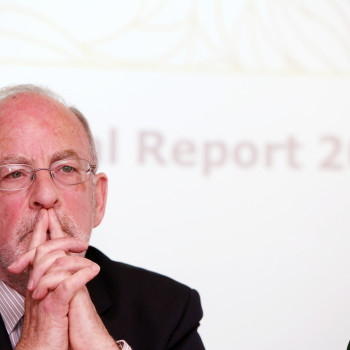Low interest rates won’t last forever

Ireland’s recent economic recovery has been largely based on low interest rates from the European Central Bank. When these rates rise later this year, will our recovery evaporate? Dan White reports
17 June 2015
The recent sharp fall in global bond prices serves as a warning that the current ultra-low interest rates won’t last forever. With the Fed now signalling a rate increase some time later this year, borrowers everywhere need to start preparing for higher interest rates.
In 2008, as the global economy crashed and the international financial system teetered on the brink of total meltdown, the world’s major central banks slashed interest rates to unprecedentedly low levels.
The official ECB interest rate now stands at just 0.05%. Rates in the US and the UK aren’t much higher with the official Fed rate having been cut to 0.25% while the Bank of England reduced official UK rates to just 0.5%.
Not alone did the major central banks cut official interest rates, which are the main determinant of the short-term rates charged by the banks, by buying government bonds – so-called “quantitative easing” – the central banks also pushed up the price of government bonds. This in turn reduced the yield or interest rate on government bonds, the main determinant of medium and long-term interest rates (bond prices and yields are inversely related – when bond prices are high, yields are low and vice versa).
Indeed so high did quantitative easing push bond prices that many bond yields turned negative – investors were effectively paying governments for the privilege of lending them money – a plainly absurd situation.
Negative yields the new normal?
Research published by investment bank Goldman Sachs in mid-April calculated that €2.1bn of Eurozone government bonds, about a third of the total, were trading on negative yields and that negative yields would be the “new normal” in the Eurozone bond markets.
Oh, dear. What a difference less than two months can make. Far from being the “new normal”, negative yields are increasingly looking like a temporary aberration. Since mid-April global bond markets, including those in the Eurozone, have tanked as investors have taken fright and started selling off bonds. The yield on benchmark ten-year German government bonds jumped from just 0.07% in mid-April to 0.99% by early June.
The sell-off wasn’t confined to German bonds. The yield on US ten-year Treasury bonds had risen to a 2015 high of 2.31% by early June.
Higher rates for borrowers
And there is almost certainly even more bad news to come from the bond markets. This in turn will feed through into higher interest rates for borrowers. Fed chairwoman Janet Yellen has already indicated that she will raise US interest rates later this year.
Speaking to a business audience in Providence, Rhode Island on 22 May, Yellen said that: “It will be appropriate at some point this year to take the initial step to raise the federal funds rate”. When America raises interest rates will the Eurozone be far behind?
But what about Greece, Italy, Spain or Portugal? Isn’t an interest rate increase the last thing that the depressed economies on the Eurozone’s southern periphery need? Maybe, but there’s more to the Eurozone than its depressed periphery. At the same time as the Mediterranean countries enter the eighth year of depression the Eurozone core, Germany in particular, is booming.
Germany keen to raise rates
With a current account surplus running at over 7% of GDP and soaring property prices, Germany badly needs higher interest rates to damp down its overheating economy. If Germany wasn’t part of the Eurozone and was still using the Deutschemark, the Bundesbank would have raised interest rates long ago. Germany’s representatives on the ECB governing council have fought ECB president Mario Draghi’s plans for quantitative easing every inch of the way and are itching for the opportunity to push up official ECB rates.
Some of the other creditor Eurozone countries such as Austria, the Netherlands and Finland would also jump at the chance of an ECB rate increase.
The plight of the periphery is still acting as a brake on these Eurozone hawks. But for how long? Things can’t continue as they have done in the Eurozone. The past seven years have cruelly exposed the design flaws in the single currency project. Turns out that the original sceptics who argued that you can’t have a single monetary policy (i.e. a single currency) without a single fiscal policy (i.e. a common treasury) were right after all.
While the latest Greek crisis remained unresolved at the time of writing, it’s difficult to see how the country can remain in the Eurozone. If the taboo on a country leaving the euro is broken what are the odds on some of the other peripheral countries quitting the single currency also?
It’s not difficult to imagine a slimmed-down Eurozone based around a Germanic core emerging over the next two or three years – and perhaps even sooner. This would be a very different Eurozone from the one we have grown accustomed to over the past sixteen-and-a-half years. A German-dominated Eurozone would see the ECB move quickly to increase interest rates. Meanwhile developments on the bond markets are pushing up medium and long-term interest rates also.
Irish very vulnerable to interest rate hikes
 And what does all of this have to do with us here in Ireland? Quite a lot as it happens. Even after the Troika-prescribed austerity of the past seven years, Ireland remains one of the most heavily-indebted countries in the world. A recent survey by consultants McKinsey found that total Irish debt levels, private as well as public, were the equivalent of 390% of GDP, second among developed countries only to Japan on 400%.
And what does all of this have to do with us here in Ireland? Quite a lot as it happens. Even after the Troika-prescribed austerity of the past seven years, Ireland remains one of the most heavily-indebted countries in the world. A recent survey by consultants McKinsey found that total Irish debt levels, private as well as public, were the equivalent of 390% of GDP, second among developed countries only to Japan on 400%.
By comparison Greece’s total indebtedness stands at “only” 317% of GDP and Spain’s at 313%. This means that Ireland is much more vulnerable to a rise in interest rates. Not alone will the cost of servicing the government’s €210bn debt rise, Irish households and companies will also feel the pinch as their monthly payments go up. Particularly vulnerable are homeowners on tracker mortgages, more than half of all mortgages, whose interest rate is directly tied to official ECB rates.
Ireland’s recent economic recovery, on which the government is pinning all of its hopes going into the general election, has been largely based on these low interest rates. When, and not if, interest rates go up we are going to find the going far tougher. Maybe that’s an argument for an October/November election rather than waiting until the last possible date in April 2016.



 Print
Print





Fans 0
Followers